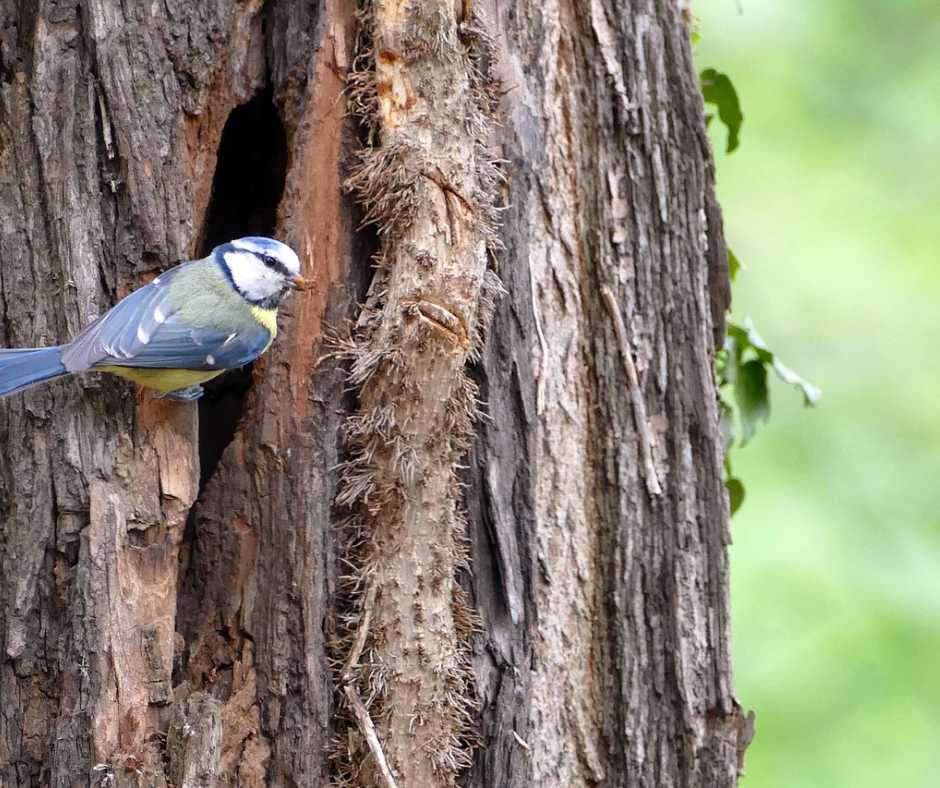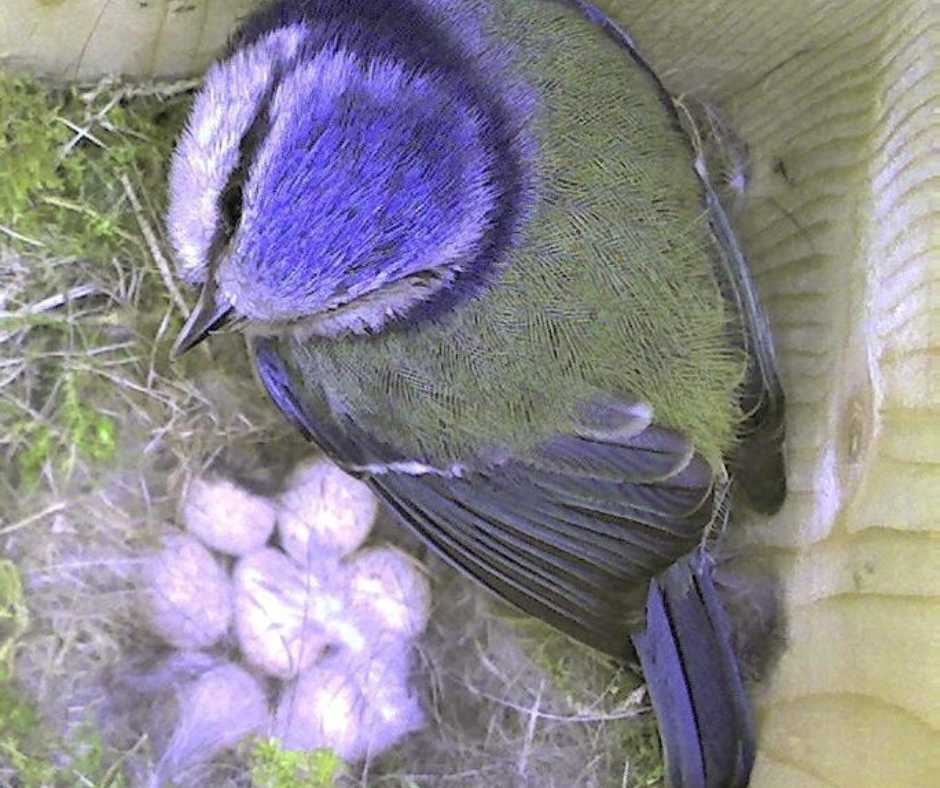Did you know that every spring, the blue tit, a small bird with a striking blue cap, embarks on an incredible journey of nesting? These little birds are cautious about where they build their homes. They pick the best spots and use different things like moss and feathers to make their nests comfy and safe.
In this article, we’ll explore how blue tits choose where to nest, build their homes, and look after their babies. Get ready to learn about these tiny birds and their big adventures in nesting!
| Aspect | Description |
| Nesting Location | Preferred sites, like holes in trees or nest boxes |
| Nest Appearance | Made of moss, wool, and feathers; small, cup-shaped |
| Breeding Season | Typically begins in late March or April |
| Mating Behavior | Monogamous; intricate courtship rituals |
| Egg Laying | Lays around 7-12 eggs; one per day |
| Incubation Period | About 14 days, mainly by the female |
| Chick Rearing | Fed by both parents; leave the nest after 18-21 days |
| Survival Rates | Varies; affected by factors like food availability, predators |
| Interesting Facts | Known for their intelligence and adaptability |
Understanding Blue Tit Nesting Locations
The choice of nesting location is vital for blue tits, as it influences their breeding and survival. These tiny birds are known for their clever selection of sites, ensuring the safety and well-being of their future offspring. Let’s delve into their preferred habitats to understand these intriguing creatures better.
Where Do Blue Tits Build Their Nests?
Blue tits are pretty particular when it comes to choosing their nesting sites. These tiny birds typically prefer areas that offer safety and seclusion. Their nests are often found in natural settings like holes in trees, especially in older woodlands.
Blue tits are good at adapting. They can even build their nests in cities, using nest boxes that people put up for them.
When they choose a place to live, they look for two critical things: enough food nearby and a safe spot away from animals that might harm them. This ability to live in different places shows how intelligent and challenging blue tits are.
How do Blue tits choose a nesting site?
Blue tits are brilliant when they pick a place to build their nests. They look for safe spots like holes in trees or buildings, away from dangers like predators. It’s also essential for them to be near lots of food, especially caterpillars, which they need to feed their chicks.
They like quiet and hidden places, which helps keep their babies safe. This wise choice of nesting spots helps make sure their little ones grow up safely.
You can also read: When Do Blue Tits Nest

The Nest Construction Process
What Does a Blue Tit Nest Look Like?
A blue tit’s nest is a marvel of natural engineering, showcasing the bird’s remarkable nesting skills. These nests are typically cup-shaped and skillfully crafted using materials such as moss, wool, and feathers.
The interior is often lined with softer materials, creating a cozy environment for the eggs and chicks. Blue tits are known to be resourceful, using whatever materials are available in their environment.
The construction of these nests reflects the bird’s dedication to providing a safe and comfortable space for their offspring. This process demonstrates their resourcefulness and adaptability to different environments, whether in a natural tree hole or a manufactured nest box.
What Materials Do Blue Tits Use to Build Their Nests?
Blue tits use moss, grass, feathers, wool, and animal hair to build their nests.
These materials are carefully chosen for their specific properties. Moss and grass create a sturdy and insulated base, while feathers, wool, and animal hair provide a soft, warm lining for the delicate eggs and chicks.
This selection showcases the blue tit’s ability to adaptively use available resources adaptively, ensuring the nest is both safe and comfortable for its young.
What Are the Common Predators of Blue Tit Nests?
Blue tit nests face threats from several predators. Birds like magpies, jays, and crows, known for eating eggs and chicks, are dangerous. Cats, both pet and wild, and squirrels threaten these nests by eating eggs.
To protect their chicks, blue tits hide their nests in thick leaves or hard-to-reach places. But even with these innovative hiding spots, they still need help to keep their chicks utterly safe from these predators. This is a big challenge for blue tits, especially when it comes to raising their babies successfully.
Environmental Impact on Blue Tit Nesting
Changes in the climate and loss of natural homes are big problems for blue tits when they nest. It messes up their breeding times when it gets too warm, and sometimes, their baby birds hatch when there aren’t enough caterpillars to eat.
Also, as more buildings are made, and forests are cut down, blue tits lose their natural nesting spots and have to find new places that might not be as good. This makes it harder for them to find food and safe places to live, affecting their chances of having and raising healthy chicks.
Blue Tit Diet During Nesting
When blue tits have baby birds, they feed them lots of caterpillars and other insects. These insects are significant for the baby birds to grow strong and healthy. Most caterpillars are around when it’s time for bluetits to breed, which is perfect because they need lots of food then.
The parent birds eat more insects, too, so they have enough energy to care for their chicks. If there aren’t enough insects, it can be hard for them to raise their babies successfully.
Blue Tit Breeding Insights
Springtime in the blue-tit world is not about warmer weather but love and partnership. These tiny birds get busy with more than just building nests. They’re also fluttering into the season of romance. Let’s dive into how and when these feathered friends start their family life.
When Do Blue Tits Breed?
Blue tits begin their breeding season in late March or April. The timing can vary slightly depending on environmental conditions such as temperature and food availability. This period is crucial as it aligns with the peak availability of caterpillars, their primary food source during nesting.
How Do Blue Tits Mate?
The mating rituals of blue tits are a blend of intricate dances and calls. Males attract females by displaying their vibrant plumage and performing courtship songs.
Once a pair forms, they often remain monogamous throughout the breeding season, working together to build their nest and raise their young. This bonding process is crucial to their reproductive success and showcases the importance of partnership in the avian world.

Conservation Efforts for Blue Tits
To help blue tits, people are working to protect their natural homes and give them safe places to nest. Special boxes are being put up for them to nest in, especially where their natural homes are gone because of buildings or trees being cut down.
People who care about birds are pushing for this. They’re also trying to bring back natural areas like woods and bushes. This helps ensure bluetits have enough food and good places to live, which are essential to survive and have baby birds.
Caring for the Next Generation
How Do Blue Tits Care for Their Eggs and Chicks?
Blue tits take great care of their eggs and chicks. Each egg is very light, about 1 gram, which is a lot for the mother’s size. She lays 7-12 eggs and keeps them warm for about 14 days.
After they hatch, both parents work hard to feed them, primarily caterpillars. In 18-21 days, the chicks are ready to be on their own. This loving care from the parents is critical for the chicks to grow healthy.
What Role Does the Male Blue Tit Play in Nesting and Raising the Young?
The male blue tit plays a crucial role in nesting and raising the young. During the nesting phase, he assists in building the nest and often guards it. Once the female lays eggs, the male’s primary responsibility shifts to providing food for her while she incubates them.
After the chicks hatch, the male contributes to feeding them. Studies have shown that male blue tits can make up to hundreds of feeding trips per day, ensuring that the chicks receive adequate nutrition for healthy growth. This active involvement of the male is vital for the survival and well-being of both the female and the offspring.
Survival and Challenges
The survival statistics, such as only 37% of chicks surviving into adulthood and 40-45% of blue tits surviving the harsh fall and winter, can be used here to discuss the survival challenges and the resilience of blue tits. – Source: birdnature.com
What Are the Survival Rates for Blue Tits?
Survival rates for blue tits can vary due to various challenges. These include environmental factors, availability of food, and predation risks.
On average, a significant number of chicks may not survive to adulthood. The quality of the nesting site, enough food, and the weather conditions during the breeding season influence the survival rate.
Adult blue tits also face threats from predators and harsh weather, impacting their overall population stability. These survival challenges highlight the delicate balance within their ecosystem.
People Also Asked
What can I do to attract blue tits to my garden?
Plant native shrubs and trees, especially those that produce berries. Install a bird feeder with seeds and a water source. Nest boxes are also practical, especially in a quiet, sheltered spot.
How do blue tits communicate with each other?
Blue tits use a variety of calls and songs for different purposes, including attracting mates, signaling danger, and coordinating with their partners while raising chicks.
Do blue tits migrate in winter?
Blue tits are generally resident birds and do not migrate. They stay in the same area year-round, although they may roam locally for food during colder months.
How can I tell if blue tits are using a nest box?
Look for signs like frequent bird visits, especially carrying nesting materials in spring or food during the breeding season. Avoid disturbing the box to protect the nesting birds.
Wrap Up
As we wrap up our exploration of blue tit nesting, it’s incredible to know there are so many of them in the UK – over 3.5 million pairs! The RSPB, a bird charity, tells us this. It shows how important these birds are to nature. We must take care of their natural homes to ensure they keep thriving and help keep nature balanced.

